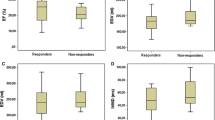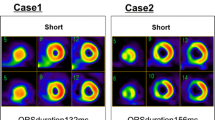Abstract.
In spite of smaller infarct size and better preserved left ventricular function the long-term prognosis after a non-Q-wave infarction is not better than after a Q-wave infarction. In fact, the risk of sudden cardiac death is higher in patients with a non-Q-wave infarction than in patients with a Q-wave infarction. One possible reason for postinfarction arrhythmias is cardiac adrenergic denervation resulting from myocardial infarction. In this study we compared cardiac adrenergic innervation after non-Q-wave and Q-wave infarctions. Single-photon emission tomography using iodine-123 metaiodobentzylguanidine (MIBG) and technetium-99m sestamibi (MIBI) tracers were conducted in order to compare cardiac adrenergic denervation and myocardial perfusion in 12 patients with a non-Q-wave infarction and 15 patients with a Q-wave infarction. MIBG and MIBI defects were determined as regional uptake ≤30% of maximal myocardial activity. The size of MIBI defects calculated as a percentage of left ventricular mass was significantly smaller in patients with a non-Q-wave infarction than in patients with a Q-wave infarction (4%±3% vs 9%±7%, P<0.05, respectively). According to the maximal serum creatine kinase activity, less myocardium was damaged in patients with a non-Q-wave infarction than in patients with a Q-wave infarction (502±436 IU/l vs 1878± 1265 IU/l, P<0.001). In spite of this, the extent of MIBG defects was similar in patients with a non-Q-wave and patients with a Q-wave infarction (21%±18% vs 23%± 12%, respectively). In addition, the size of MIBG defect correlated with the infarct size (maximal creatine kinase activity) (r=0.52, P<0.05) after a Q-wave infarction but not after a non-Q-wave infarction. In conclusion, despite a smaller infarct size in non-Q-wave infarct patients, the extent of cardiac adrenergic denervation was similar in patients with a non-Q-wave and patients with a Q-wave infarction. In addition, the extent of cardiac adrenergic denervation was related to the infarct size in patients with a Q-wave infarction but not in patients with a non-Q-wave infarction.
Similar content being viewed by others
Author information
Authors and Affiliations
Additional information
Received 19 January 2000 and in revised form 24 March 2000
Rights and permissions
About this article
Cite this article
Simula, S., Lakka, T., Laitinen, T. et al. Cardiac adrenergic denervation in patients with non-Q-wave versus Q-wave myocardial infarction. Eur J Nucl Med 27, 816–821 (2000). https://doi.org/10.1007/s002590000278
Issue Date:
DOI: https://doi.org/10.1007/s002590000278




